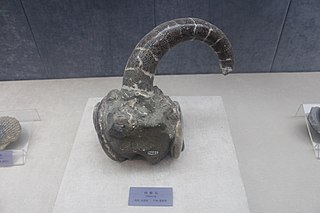
Ammonoids are a group of extinct marine mollusc animals in the subclass Ammonoidea of the class Cephalopoda. These molluscs, commonly referred to as ammonites, are more closely related to living coleoids than they are to shelled nautiloids such as the living Nautilus species. The earliest ammonites appear during the Devonian, and the last species vanished in the Cretaceous–Paleogene extinction event.

Hamites ("hook-like") is a genus of heteromorph ammonite that evolved late in the Aptian stage of the Early Cretaceous and lasted into the Cenomanian stage of the Late Cretaceous. The genus is almost certainly paraphyletic but remains in wide use as a "catch all" for heteromorph ammonites of the superfamily Turrilitoidea that do not neatly fit into the more derived groupings. In an attempt to identify clades within the genus, it has been divided up into a series of new genera or subgenera by different palaeontologists, including Eohamites, Hamitella, Helicohamites, Lytohamites, Planohamites, Psilohamites, and Sziveshamites.
The Cenomanian is, in the ICS' geological timescale, the oldest or earliest age of the Late Cretaceous epoch or the lowest stage of the Upper Cretaceous series. An age is a unit of geochronology; it is a unit of time; the stage is a unit in the stratigraphic column deposited during the corresponding age. Both age and stage bear the same name.

Euhoplites is an extinct ammonoid cephalopod from the Lower Cretaceous, characterized by strongly ribbed, more or less evolute, compressed to inflated shells with flat or concave ribs, typically with a deep narrow groove running down the middle. In some, ribs seem to zigzag between umbilical tubercles and parallel ventrolateral clavi. In others the ribs are flexuous and curve forward from the umbilical shoulder and lap onto either side of the venter.
Kamerunoceras is an extinct cephalopod genus belonging to the ammonite family Acanthoceratidae, found in Upper Cretaceous formations of Africa, Europe and North and South America.
Utaturiceras is an upper Cretaceous (Cenomanian) ammonitid belonging to the family Acanthoceratidae and subfamily Mantelliceratinae.

Acanthoceratidae is an extinct family of acanthoceratoid cephalopods in the order Ammonitida, known from the Upper Cretaceous. The type genus is Acanthoceras.
Morrowites, named by Cobban and Hook, 1983, is a moderate to large-sized ammonite with quadrangular to depressed whorls, broadly rounded to depressed venter, low ribs, umbilical and inner and outer ventrolateral tubercles and smooth early whorls except for occasional ribs along weak constrictions. The suture is moderately simple and has an unusually broad bifid first lateral lobe. It is so far restricted to the Lower Turonian stage, in the mid Cretaceous.

Mammites is a Late Cretaceous ammonite genus included in the acanthoceratoidean family, Acanthoceratidae, and the type genus for the subfamily Mammitinae. Mammites was named by Laube and Bruder in 1887.
Brancoceratidae is a family of acanthoceratoid ammonites from the middle of the Cretaceous, recognized by their commonly evolute shells with round, oval, or quadrate whorls, strong ribs, usual ventral keels, and at least, umblical tubercles. The family is thought to be derived from the Desmoceratidae (Desmoceratoidea), perhaps from Silesitoides or some allied genus.

Calycoceras is an extinct genus of cephalopods belonging to the subclass Ammonoidea and family Acanthoceratidae that lived during the Cenomanian stage of the Late Cretaceous, 100-94 Mya. Their shells had ornate ribs.
Leymeriellidae is a family of Lower Cretaceous ammonites comprising rather small forms distinguished from Hoplitidae by their flattened and grooved ribs and virtual absence of umbilical tubercles. The family is derived from the Desmoceratidae. Leymeriella schrammeni anterior has evolved from Desmoceras keilhacki keilhacki.

Eucalycoceras is an extinct genus of cephalopods belonging to the Ammonite subclass.

Turrilites (Turrilites) costatus is a species of helically coiled ammonoid cephalopod, from the lower part of the Upper Cretaceous (Cenomanian).

The Acanthoceratinae comprise a subfamily of ammonoid cephalopods that lived during the Late Cretaceous from the latter early Cenomanian to the late Turonian
Cunningtoniceras is a stocky acanthoceratid ammonite from the upper Cenomanian stage of the late Cretaceous of the western U.S., found e.g. in Arizona and New Mexico.
Neocardioceras is a genus of evolute acanthoceratid ammonites from the uppermost Cenomanian, Upper Cretaceous, of Europe, western U.S. and Brazil.
Quitmaniceras is a genus of small, compressed, fairly evolute ammonites from the lower Turonian of Grant County, New Mexico and Trans-Pecos Texas, included in the subfamily Acanthoceratinae. The shell has a carinate venter in juveniles and one that is arched in adults, usually with a raised siphonal line,(siphonal referring to the marginal siphuncle). Ribs are very weak to moderately strong, flexious, typically sloping forward toward the rim, bending further forward at the outer shoulder.
Euomphaloceras is an early Upper Cretaceous ammonite genus,, included in the Acanthoceratinae until established as the type genus for the Euomphaloceratinae by Cooper, 1978.








